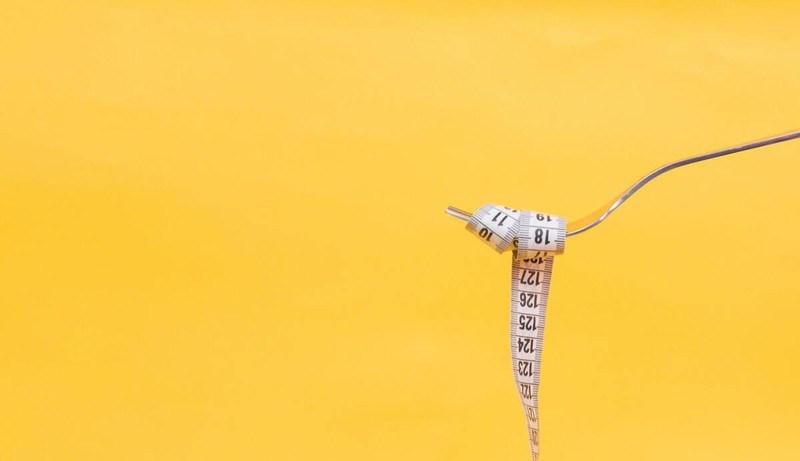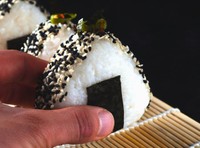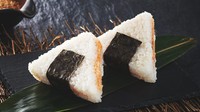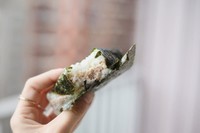How many calories does an onigiri contain?
The onigiri is known for its nutritional qualities but could an onigiri help you maintain your figure and even lose weight?

Onigiri is mainly made of rice. This rice ball is very high in carbohydrates and relatively low in protein, which makes it an ideal food to eat regularly when you are trying to stay in shape or gain muscle. However, beware of weight gain.
Table of contents
- How many calories in an onigiri?
- What are the nutritional benefits of onigiri?
- How to know if an onigiri is healthy?
- Knowing the ingredients of onigiri
- Rice
- The nori seaweed
- The sugar
- The fillings
- Understanding the number of calories in an onigiri
- Which onigiri is the worst and best for weight loss?
- Tuna and mayonnaise onigiri
- Nikumaki, ongiri with sliced pork
- Umeboshi onigiri (ume okaka), plum onigiri
- Salmon onigiri
- Chicken onigiri
- How to make your own healthy onigiri?
- Be sure to increase your activity level when eating onigiri
How many calories in an onigiri?
There are so many variations that it is quite difficult to determine the exact caloric intake of the food. But, generally speaking, it ranges from 165 kcal to 200 kcal depending on the filling chosen.
What are the nutritional benefits of onigiri?
This traditional Japanese specialty has good nutritional value. It contains sodium, good carbohydrates and fibre and, depending on the choice of other ingredients for the filling, it can even be a good source of protein. The snack is filling, digestible and has appetite regulating properties, so eating it as an appetizer or snack helps limit the amount of food you eat at your next meal. The fact that it comes in many versions means that it can be adapted to all eating styles.
How to know if an onigiri is healthy?
In this section I will list my five tips for selecting the best onigiri according to my goals.
Knowing the ingredients of onigiri
Onigiri is one of the easiest foods to prepare, as it requires very few ingredients and the process of assembling it is simple and fun.
Rice
This is one of the main ingredients in onigiri and is also the main reason why onigiri is not the ideal food for weight loss. Since rice is mostly simple carbohydrates, this means that it will add a lot of extra calories to your meal without filling you up if you don't eat anything else. When you are trying to lose weight, make sure that you consume little rice and that the portion size remains correct.
The nori seaweed
From sushi to any Japanese soup, seaweed is a common ingredient used in many Japanese dishes. Often used for its flavorful properties, it is an essential component to give your onigiri that crunchy outer texture. Seaweed is another low-calorie ingredient that contains very little carbohydrates and fat and is an excellent source of protein. Filled with antioxidants and fiber, seaweed is frequently added to Asian dishes to give them a little extra flavor and crunch.
The sugar
The sugar and vinegar mixed with the rice gives the rice that sweet and salty flavor that gives the onigiri ball that unique and addictive taste. Sugar is another form of simple carbohydrate that we want to make sure we regulate when trying to lose weight.
Not only does consuming a lot of sugar add a lot of extra calories to your meals, but sugar often makes you hungrier and crave more sugary foods after a meal. Limit your daily sugar intake to help reduce the amount of calories you consume throughout the day as well as maintain a healthy, balanced diet.
The fillings
Onigiris have a wide variety of different fillings, with salmon and tuna being among the most popular dried plums and vegetarian favorites.
Understanding the number of calories in an onigiri
Now that you have a good idea of the different types of ingredients that go into an onigiri, let's discuss the nutritional information. Understand that macronutrients and calories are essential for weight loss A classic onigiri without toppings contains about 180 calories with 2g of fat, 36g of carbohydrates, and 5g of protein.
Which onigiri is the worst and best for weight loss?
In this section, we'll cover five of the most popular onigiri and how different toppings can dramatically change the macronutrients and calories of an onigiri.
Tuna and mayonnaise onigiri
Made with canned tuna and mayonnaise, the Tuna Mayonnaise Onigiri is a delicious and tasty rice ball that has the perfect sweet and salt balance.
For every Tuna Mayonnaise Onigiri, there are a total of 280 calories with 13g of fat, 31g of carbs and 16g of protein.
So this recipe has a good amount of protein, but also a lot of extra fat and carbs, making it the worst option for weight loss, but if you remove the mayonnaise from the onigiri, it actually turns out to be a much lower calorie rice ball!
Nikumaki, ongiri with sliced pork
Nikumaki is probably the most atypical onigiri of the five. Rather than having a filling, Nikumaki is wrapped with thinly sliced pork that wraps neatly around the rice.
For each Nikumaki, there are a total of 250 calories with 6g of fat, 34g of carbohydrates and 13g of protein.
Less fatty than the previous recipe, nikumaki is a better low calorie option.
Umeboshi onigiri (ume okaka), plum onigiri
Umeboshi Onigiri is a delicious rice ball filled with dried pink plums, which add a lot of salt and acidity to your onigiri ball.This unique onigiri flavor is very popular in Japan and has also become a favorite among the general public.
For every Umeboshi Onigiri, there are a total of 180 calories with 1g of fat, 40g of carbohydrates, and 4g of protein.
This is the lowest calorie onigiri, which is a good thing to have, but it is also very low in protein. If you've eaten a lot of high protein foods throughout the day, Umeboshi Onigiri can be a great snack if you're really craving a rice ball.
Salmon onigiri
One of the most popular options is the Salmon Onigiri and Tuna Mayo. Filled with dried salmon flakes, the Salmon Onigiri is a delicious onigiri that is a perfect balance of sweet and salty.
For each salmon onigiri, there are approximately 200 calories with 2g of fat, 34g of carbohydrates and 10g of protein.
Very low in fat and relatively high in protein, salmon onigiri is a better low-calorie option than other onigiris.
Chicken onigiri
Made with chicken thighs, chicken onigiri is a delicious and satisfying option that is high in protein and tasty.
For each chicken onigiri, there are approximately 230 calories with 5g of fat, 31g of carbohydrates and 14g of protein.
Made with less fat and more protein, chicken onigiri is one of the best options that are higher in protein and lower in fat.
Leaning towards being one of the slightly lower carbohydrate onigiris, it is probably the best option to choose when trying to lose weight.
How to make your own healthy onigiri?
Use less rice and add more low-calorie, high-protein fillings. Add vegetables to your onigiris to feel fuller faster.
Be sure to increase your activity level when eating onigiri
Remember that while nutrition is an important factor influencing weight loss, it is also crucial to combine this journey with exercise. Especially strength training. Several years of research on the benefits of strength training have shown that people who do resistance training, at least 3-5 times a week, lose or maintain their weight.





